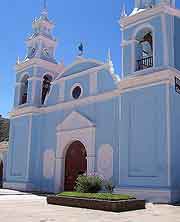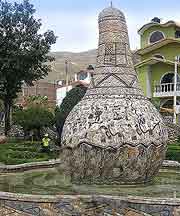Huancayo History Facts and Timeline
(Huancayo, Junin, Peru)

Huancayo, the capital of both its namesake province and Peru's central Junin region, stands in the Mantaro Valley's lower end, where it is surrounded by towering mountains.
The Huancayo-Jauja region forms the fifth-most densely populated metropolitan area in Peru, with this city playing a central part of Peru's main commercial and cultural activities. Beneath the city's endless sprawl of concrete buildings lies the long and proud history of Huancayo. Amongst the city's principal attractions are its naturally eroded Torre Torre sandstone towers and its landscaped Parque de la Identidad Huanca, which comes complete with arches, ornate walls with balustrading, numerous statues and attractive fountains.
Huanca Settlement
Both the city and its original Huanca inhabitants were named after the Quechua word for 'stone'. The Huanca warriors became part of the Wari Empire around the year of 500 BC and later constructed the Warivilea Temple along the banks of a stream that they considered to be sacred.
The Warivilea Temple was built in the region of 1,000 years ago, although it wasn't discovered until as recently as the mid-1930s. Ancient ceramics, skulls and various other artefacts from this period in the history of Huancayo are displayed at the popular onsite museum-type attraction.
Pachacutec and Spanish Conquest
In the year of 1460, Inca leader Pachacutec incorporated the region into the vast Inca Empire, after a valiant fight and much convincing from Pachacutec's brother, Capac Yupanqui. Huancayo then became an important place to stop on the busy thoroughfare named the Inca Camino Real. Although the Spanish conquered nearby Jauja in 1534, the city did not formally become Spanish territory until 1570. Two years later, the city was officially established as Santisima Trinidad de Huancayo, with a large inauguration ceremony being based on the present-day Huamanmarca Square.
Insurmountable City
In 1820, this became one of the first Peruvian cities to declare its independence from Spain, earning Huancayo its 'Insurmountable City' nickname. Construction of the city's cathedral began at the beginning of the following decade, while a statue stands within the Constitución Plaza, commemorating the moment Peru banned slavery in 1854. The next battle in the history of the city came from Chile, which unsuccessfully fought against 'Wizard of the Andes' General Andrés Avelino Cáceres Dorregaray in 1879.

Earthquakes and Landslides History
Huancayo became a far less isolated city when the railway arrived here in 1908, connecting the capital of
Lima. The nine-hour rail journey between the two cities still travels past some of Peru's most breathtaking scenery and over the highest railway bridge on the planet, although the route is sadly no longer open to passenger traffic.
The late 1960s marked a time of devastation for the city, when two earthquakes and several subsequent landslides killed well over 1,000 people and destroyed much of Huancayo. Many of those who survived the earthquakes found their homes and belongings completely destroyed by this natural disaster.
Modern-Day Festivals and Attractions
Modern constructions may far outnumber picturesque colonial buildings in modern Huancayo, but the city still hosts just as many cultural festivals today as during the time of Spanish rule.
Local vendors have sold metalwork, intricately carved gourds, ceramics, cloth, livestock and fresh produce at the city's bustling Sunday fair since the founding of Huancayo all the way back in 1572.
 Huancayo, the capital of both its namesake province and Peru's central Junin region, stands in the Mantaro Valley's lower end, where it is surrounded by towering mountains.
Huancayo, the capital of both its namesake province and Peru's central Junin region, stands in the Mantaro Valley's lower end, where it is surrounded by towering mountains.